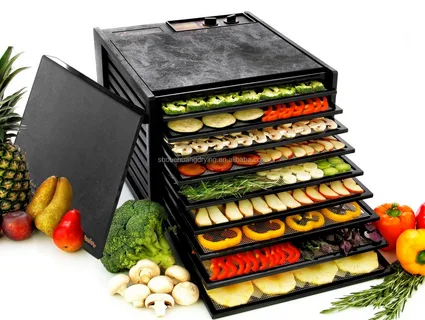In an age where healthy eating is paramount, a food dehydrator can be a game-changer in your kitchen. A food dehydrator is not just another kitchen gadget; it’s a powerful tool that allows you to create delicious, nutrient-rich snacks while preserving your food’s natural flavours and goodness. If you’re seeking healthier alternatives to store-bought snacks, investing in a dehydrator could be the key to unlocking a world of homemade treats that are both tasty and nutritious. With a dehydrator, you can transform fresh fruits, vegetables, and even meats into convenient, long-lasting snacks that retain their essential nutrients.
Introduction to Food Dehydrators and How They Work
A food dehydrator removes moisture from food through a controlled heat source and airflow. This process inhibits the growth of bacteria, yeast, and mould, which thrive in moist environments, extending the shelf life of various foods. The appliance works by circulating warm air evenly around the food placed on trays, gradually reducing the water content without cooking it. This preservation method retains more of the food’s nutrients, flavours, and colours than traditional methods like canning or freezing.
Dehydrators are available in various sizes and configurations, from compact units ideal for small kitchens to larger, more advanced models suitable for extensive food preservation. Most dehydrators feature adjustable temperature settings and timers, providing flexibility to tailor the drying process to different types of food. For instance, fruits and herbs often require lower temperatures, while meats necessitate higher settings to ensure safety and proper dehydration.
One significant advantage of using a dehydrator is the ability to enjoy seasonal produce throughout the year. By dehydrating fruits and vegetables at their peak ripeness, you can lock in their nutritional value and savour their natural flavours long after the growing season. Many units come with multiple trays, allowing you to dehydrate different foods simultaneously without mixing flavours.
The dehydration process is straightforward:
- Prepare your food by washing and slicing it uniformly.
- Place it on the tray set.
- Set the desired temperature and time. letting
- Let the dehydrator do the rest.
Some foods, like apples or bananas, may benefit from a quick pre-treatment with lemon juice to prevent browning and enhance flavour. You can transform fresh produce into healthy, shelf-stable snacks and ingredients with minimal effort.
Health Benefits of Using a Dehydrator for Snacks
A dehydrator offers many health benefits that can enhance your snacking habits. One primary advantage is that dehydrated foods maintain the majority of their vitamins and minerals, ensuring you get a nutritious boost with every bite. Unlike many commercial snacks laden with preservatives, added sugars, and unhealthy fats, homemade dehydrated snacks give you full control over the ingredients, making it easier to stick to a clean and wholesome diet.
Dehydrated fruits like apples, bananas, and strawberries are fantastic sources of fibre and essential nutrients. These naturally sweet treats are perfect for those looking to cut down on processed sugars and unhealthy additives. Dehydrated vegetables can be turned into crispy chips or flavorful powders, adding a nutritious crunch to your meals or serving as a healthy alternative to traditional snack options.
For those with dietary restrictions or food allergies, dehydrating your snacks allows you to avoid potential allergens and create safe, enjoyable options tailored to your needs. It also empowers you to experiment with different flavour profiles and combinations, such as adding your favourite spices or herbs for a personalized touch.
Furthermore, dehydrating food can help you manage portion sizes more effectively, allowing you to create perfectly portioned snacks that satisfy your hunger without overindulging. This is especially beneficial for those looking to maintain or lose weight, as it makes monitoring and controlling caloric intake easier.
The possibilities are endless with a dehydrator, and the health benefits are substantial. From nutrient retention to allergen control, this kitchen appliance is a must-have for anyone committed to a healthier lifestyle.
Popular Foods You Can Dehydrate at Home
The versatility of a dehydrator allows you to experiment with a wide variety of foods:
Fruits
Common choices include apples, bananas, mangoes, peaches, and strawberries. These dried fruits are fantastic for snacking, adding to cereals, or mixing into trail mixes.
Vegetables
Carrots, bell peppers, zucchini, and tomatoes are ideal for making crunchy chips or flavorful additions to soups and stews. They also work well in homemade seasoning blends.
Herbs
Basil, oregano, thyme, and other fresh herbs can be easily dehydrated and stored for extended use, perfect for flavouring your culinary creations.
Jerky
One of the most popular uses for a dehydrator is making jerky from lean meats such as beef, turkey, or chicken. Create custom marinades for unique flavours without the preservatives commonly found in store-bought options.
Nuts and Seeds
Lightly roasting nuts and seeds in a dehydrator enhances their flavour without the risk of burning, offering a tasty and nutritious snack.
This list is just the beginning; the potential combinations and flavours you can create with a dehydrator are virtually limitless.
Tips for Successful Food Dehydration
To ensure optimal results when using your dehydrator, keep these practical tips in mind:
Select Quality Produce
Start with fresh, ripe, high-quality fruits and vegetables. Avoid using overripe or damaged items, as they won’t dehydrate well and could compromise the taste and texture of your final product.
Uniform Slicing
Cutting your food into uniform slices is crucial for even dehydration. Consistent thickness ensures that all pieces dry simultaneously, preventing some from becoming too brittle while others remain moist.
Pre-Treatment
Certain fruits like apples and bananas benefit from a brief soak in lemon juice or ascorbic acid solution. This step helps prevent browning and can enhance the flavour of your dried snacks.
Avoid Overcrowding
Arrange your food items on the dehydrator trays with sufficient space between them. Proper airflow is essential for even dehydration; overcrowding can lead to uneven drying and longer processing times.
Temperature Settings
Different foods require different temperatures. For example, fruits typically dry well at around 135°F, while meats like beef jerky need higher temperatures, approximately 160°F, to ensure safe dehydration. Always refer to the guidelines for the specific food you are drying.
Monitor Progress
Periodically check the progress of your dehydration. If your dehydrator has no automatic rotation feature, rotate trays to ensure even drying.
Store Properly
Once your food is dehydrated, let it cool completely before storing it in airtight containers. This step prevents any remaining moisture from causing spoilage. Using vacuum-sealed bags or jars with moisture absorbers can extend the shelf life of your dehydrated goods.
By following these tips, you’ll be well on your way to creating delicious and healthy dehydrated snacks with consistent results every time.
Delicious and Easy Dehydrator Recipes to Try
Exploring new recipes with your dehydrator can be both fun and rewarding. Here are some easy-to-follow ideas to get you started:
Cinnamon Apple Chips
Slice apples thinly and soak them briefly in lemon juice to prevent browning. Sprinkle with cinnamon and dehydrate at 135°F until crisp. These make a sweet, healthy snack that’s perfect for on-the-go munching.
Veggie Chips
Kale, sweet potatoes, and beets are excellent choices for veggie chips. Slice your veggies thinly, toss them in olive oil and your favourite seasonings, and then dehydrate until they reach your desired level of crunch. These can serve as a fantastic alternative to store-bought chips.
Fruit Roll-Ups
Puree your favourite fruits, like strawberries, mangoes, or apples, and spread the mixture evenly on a dehydrator sheet. Dehydrate at 135°F until the fruit leather is pliable but not sticky. Roll them up in parchment paper for a convenient, portable treat.
Herb Seasoning
Fresh herbs such as basil, rosemary, and thyme can be dehydrated and ground into a powder to create your seasoning blends. This is an excellent way to preserve the flavours of your herb garden year-round.
Spicy Beef Jerky
Marinate lean strips of beef in a mixture of soy sauce, garlic, and your favorite spices. Dehydrate at 160°F until the jerky is firm but still pliable. This homemade jerky is perfect for snacking or adding protein to your meals.
These recipes are just the beginning of what you can do with your dehydrator. With a little creativity, the possibilities are endless!
Cleaning and Maintaining Your Food Dryer
Proper cleaning and maintenance of your food fryer are essential for ensuring the appliance’s longevity and the safety of the food you prepare. Start by unplugging the unit and allowing it to cool completely before you begin cleaning. Most dehydrators come with removable trays, which should be taken out and washed with warm, soapy water. Use a soft brush or sponge to remove any stuck-on food particles. For particularly stubborn residues, soaking the trays in a vinegar and water solution can help break down any build-up.
The main body of the dehydrator, including the fan and heating element, should be wiped down with a damp cloth. Be cautious not to let water seep into the electrical components. If your dehydrator has a drip tray, it’s crucial to clean it to prevent mould or bacteria growth.
Those using a mesh screen or liner can usually be cleaned by gently scrubbing with a soft brush. Ensure they are thoroughly dry before placing them back in the dehydrator to avoid any moisture build-up, which could compromise dehydration.
Regularly inspect the vents and fan to ensure they are free of dust and debris, which can impact airflow and efficiency. Using a small brush or vacuum can help keep these areas clean.
Finally, always refer to the manufacturer’s guidelines for specific cleaning instructions or maintenance tips. Proper care not only extends the life of your dehydrator but also ensures that every batch of dehydrated food is safe and delicious.
Eco-Friendly and Budget Benefits of Dehydrating Food
Investing in a dehydrator offers substantial eco-friendly and budgetary advantages. Purchasing fresh produce in bulk, especially in season, is often more economical. Dehydrating these items allows you to preserve them for future use, significantly reducing food waste by saving excess fruits and vegetables from spoiling. This preservation method means you can enjoy seasonal produce’s taste and nutritional benefits year-round without the added cost of off-season prices.
Homemade dehydrated snacks are generally much cheaper than store-bought versions, particularly regarding organic or specialty options. By preparing your snacks, you avoid the markup associated with commercial packaging and branding, leading to considerable savings over time. Additionally, creating your dried foods helps reduce packaging waste, as there’s no need for single-use plastic wrappers or bags, making it a more sustainable choice.
Furthermore, many store-bought dehydrated products contain preservatives, artificial flavours, and added sugars. By making your own, you have complete control over the ingredients, ensuring your snacks are healthier and free from unnecessary additives. This benefits your wallet and promotes a cleaner, more eco-friendly lifestyle.
Conclusion
Incorporating a dehydrator into your culinary routine opens up a world of nutritious and delectable possibilities. With the ability to preserve seasonal produce, you ensure that fresh, flavorful fruits and vegetables are available all year. The process is straightforward and highly customizable, allowing you to experiment with various foods and create snacks that suit your tastes and dietary preferences. Beyond the health benefits, dehydrating your food is also cost-effective and eco-friendly, reducing food waste and reliance on commercially packaged snacks. The joy of crafting your own dried fruits, vegetable chips, herbs, and even jerky can transform how you think about snacking and meal prep.
FAQs
Q: How long does it take to dehydrate food?
A: The dehydration time varies depending on the type and thickness of the food. Fruits can take 6 to 12 hours, while vegetables might dehydrate within 4 to 10 hours. Meats, like jerky, usually require 6 to 8 hours. Always refer to specific guidelines for best results.
Q: Can I dehydrate cooked foods?
A: Yes, cooked foods can be dehydrated. However, ensure they are evenly sliced and free of excess moisture to facilitate efficient drying.
Q: Is a food dehydrator energy-efficient?
A: Generally, dehydrators use less energy compared to ovens. They are designed to operate at lower temperatures over extended periods, making them an energy-efficient option for food preservation.
| Related Business Listings |
| Contact Directory |
| Local Business Profiles |




